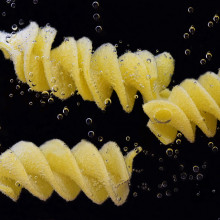Why does fresh pasta rise during cooking?
Martin wanted to know why fresh pasta rises to the surface of the pot when it's ready. We asked Dr Chris Brock from London South Bank University.
In this episode

00:00 - Why does fresh pasta rise during cooking?
Why does fresh pasta rise during cooking?
Lewis Thomson put this question to Dr Christopher Brock, senior lecturer in food sciences at London South Bank University…
Christopher - The main ingredients of fresh pasta are water, eggs and durum wheat semolina which is the same material as wheat flour but it has a coarser texture. The wheat contains starch which, in raw pasta dough, is in the form of tiny granules each one just a few hundredths of millimetre across. The properties of the granules as a material are similar to microscopic beads of glass and they’re denser than water. This is why fresh, uncooked pasta like gnocchi sinks to the bottom of the pan.
Lewis - So what happens when you cook it? What makes the pasta rise?
Christopher - Well, starch is actually made up of two different carbohydrate molecules joined together - amylose and amylopectin. When pasta is cooked and it reaches about 60 degrees C, the starch granules absorb water and swell and this causes the amylose to contact and attach to the amylose from neighbouring starch granules. Imagine, if you will, the way that the wax in a lava lamp is exuded and merges with other globules of wax - it’s a similar process. Eventually, the starch is converted into a gel pervading throughout the cooked pasta. This gel contains more water and is less dense than the starch granules in raw dough. However, it’s still too dense to make the pasta rise to the surface of the water.
Lewis - Okay. So heating up the pasta makes it absorb water and lose density, but not enough to make it rise to the surface. What else is going on?
Christopher - This is where the egg comes into play. It is rich in emulsifiers which trap air inside the dough while it is being mixed and kneaded. The air remains in the cooked pasta making it more buoyant, and it’s the combined effect of the reduction in density as the starch becomes a gel and the buoyancy of the trapped air that makes the fresh pasta rise to the surface. Additional buoyancy may result from convection currents and steam filled bubbles rising from the bottom of the saucepan during cooking and pushing the pasta up towards the surface.
Lewis - But why doesn’t dried pasta rise to the surface in the same way?
Christopher - Dried pasta usually doesn’t contain egg so it contains less trapped air. When you cook dried pasta, the starch granules absorb water just like when cooking fresh pasta but this isn’t enough to make the pasta rise to the surface.
Lewis - Thanks Chris. Next time we’ll be tackling Trent’s temperature question:
The temperature where I live recently hit -40 degrees, and got me thinking, is it better to walk or to run through the cold air? Should you run to reduce the amount of time out in the cold or do the adverse effects of moving faster, like windchill, outweigh the benefits of getting to your destination quickly?
Related Content
- Previous Why Bother Being Nice?
- Next What causes heavy periods?










Comments
Add a comment